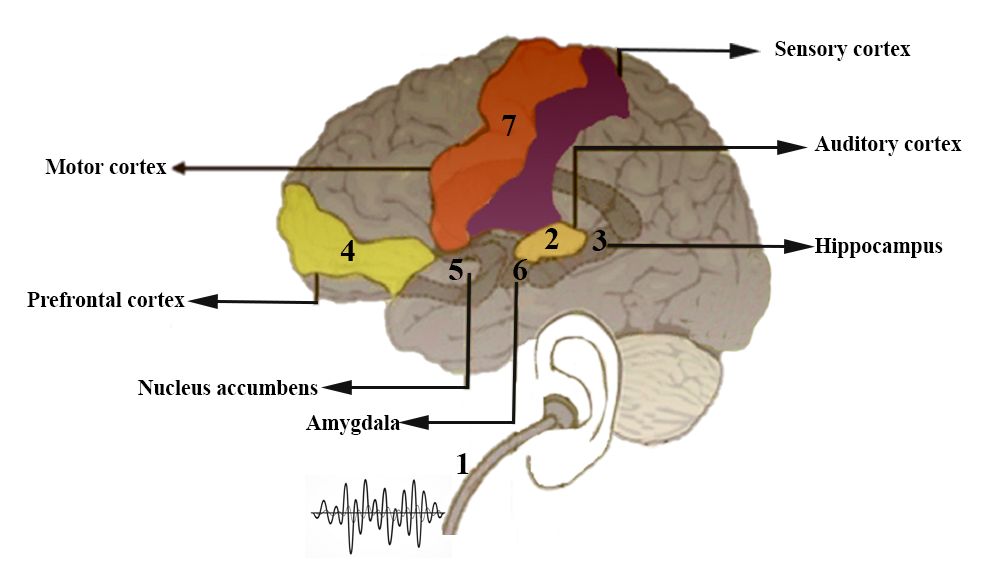Autore
Floriana Volpicelli, Carla Perrone Capano, Umberto di Porzio
Institute of Genetics and Biophysics “Adriano Buzzati Traverso”, CNR, Naples Università degli Studi di Napoli Federico II
Floriana Volpicelli Institute of Genetics and Biophysics “Adriano Buzzati Traverso”, CNR, Naples Carla Perrone Capano Institute of Genetics and Biophysics “Adriano Buzzati Traverso”, CNR, Naples - Deparment of Pharmacy, University of Naples Federico II Umberto di Porzio Institute of Genetics and Biophysics “Adriano Buzzati Traverso”, CNR, Naples
Indice
- Intro
- Evolution
- Music and emotions
- Auditory-motor synchronization
- Conclusions
S&F_n. 19_2018
Abstract
The tuned brain
Although music is not restrained to the human species and a number of nonhuman creatures produce music, especially birds and cetaceans, music appears as a unique characteristic of human beings, as language and speech. Indeed, music is probably older than speech and more universal. Music has played a central role in human culture since the beginning of humanity, subserving an important correlate to stimulate imagination, understanding, social bonds. Music, both performed and perceived, stimulates a wide range of sensory, cognitive and emotional neural processes. Emotions are a central feature of the enjoyment of music, with a great variety of emotional states in people while listening or performing. Complex cognitive abilities and cortical processes integrate with fundamental subcortical reward and motivation systems in the brain to give rise to musical pleasure. The universality of music, apparently regardless of cultures or geography, makes it a possible vehicle to explore commonalities amongst cultures and to evaluate the therapeutic impact of music in modern time.
- Intro
Fundamental questions about the nature and value of music and our experience of it as human being, have been the object of an increasing number of studies in neurobiology and philosophy.
A main question is centered around emotional responses to music, that is, the search for the neural correlates of music-evoked emotions in humans. Music training also significantly improves motor and reasoning skills, as well as memory, perception, creativity.
Although music is not a unique human activity and is shared with a number of other species, especially birds and cetaceans, music remains a specific trait of human beings, that has appeared everywhere, in all human cultures and from the deep history of humankind. Remarkably, bone-flute or animal skin drums were amongst the first human manufacturing found, dating 60-40,000 years. Apparently, singing and dancing were an ordinary activity since early human societies and brought people together, enhancing social bond and belonging, and were part of every ritual.
Many researches are aimed at unraveling what function did music serve as humankind was evolving and developing. For a long time, it was thought that the human brain had evolved specific centers to listen and to perform music. Now we know that music creation or response is distributed throughout the brain involving nearly every area of the brain identified. And that brain rewiring occurs constantly, even more, when related to listening, composing or performing music.
Children who had musical instrument training performed better than naïve pairs not only in auditory discrimination abilities and fine motor skills but also on vocabulary and non-verbal reasoning skills, which involve understanding, analyzing and processing new information. It’s fascinating to see how learning to play an instrument can help kids develop such a wide variety of important abilities.
The rewiring of the brain under the effects of music has been a marvelous example that the belief that the brain was deeply “hardwired” into an unchangeable structure, with permanently connected circuits, each designed to perform a specific, unchangeable function, was wrong. For example, training-dependent reorganization of somatosensory cortex (Fig.1) in string players determines an enlarged cortical representation of the left-hand digits, used for digitalization, while a significant interhemispheric asymmetry was present in the representation of the right-hand digits, which contrasted with the symmetrical representations in age-matched non-player controls. Neuroplasticity induced by music might represents the basis for the “healing” effects of music in patients with brain damage or neurodegeneration (see below).

Figure 1. Playing and listening to music involves several cortical and subcortical areas. The sound waves (1) travel from the outer to the inner ear and are transduced into neural impulses. The auditory cortex (2) analyses and interprets the different aspects of the sound and interacts with the hippocampus (3) and the prefrontal cortex (4) for memory formation and interpretation. The nucleus accumbens (5) and amygdala (6) are involved in emotional evaluation. The motor cortex (7) is involved in the planning and execution of voluntary movements and in sensory-motor feedback circuits.
The localization of brain functions in specific areas started in the mid-nineteen century when Paul Broca showed that the language impairment of a patient, who could only say “tan tan”, was related to a selective damaged tissue in the left frontal lobe. Thus, Broca identified the speech area, which carries his name. Together with the other two language centers, Wernicke and Geshwind, the Broca’s area is also implicated in music execution and listening.
That music is pleasurable and seems to play a role in our wellbeing, could be linked to the fact that listening or performing music requires coordination and cooperation, which increases endorphin release, generating the positive, warm feelings people experience when making music together. Until recently, music could be heard only live, during performances. Therefore, music involved contact with others (e.g. coming together for a concert or a ritual) and provided a safety net that may have strengthened social bonds and engaged brain circuits involved in empathy, trust, and cooperation since the times of the early human communities.
Nowadays we know that such social bond is largely modulated by oxytocin, a neuropeptide produced in the hypothalamus and released during sex, childbirth, and lactation to aid reproductive functions. It is known to play an important role also in increasing social ties and trust between people. Apparently, also in pair-bonding, oxytocin is also involved to establish and maintain the bond of the mother (and father) to the offspring. Researchers have discovered that music may affect oxytocin levels in the body.
Music-evoked emotions are also related to a higher release of the neurotransmitter dopamine (see below).
From a neurobiologist’s point of view, the study of interactions between music and the brain is particularly suitable for studying neuronal plasticity in the human brain, because music education is more complex and multimodal than most other activities of everyday life, and pursuing musical training requires great commitment and long time. The study of music-brain relationship refers to many brain functions such as perception, action, cognition, emotion, learning and memory, and therefore lends itself to study how the human brain works and how different brain functions interact. That is, music promoted brain reshaping by increasing synaptic efficacy, promoting new, or unmasking latent connections. In this respect, music therapy can become a powerful tool to enhance neuroplasticity in the brain to improve the quality of life of patients with a damaged nervous system. Indeed, recent studies on the effects of music-based interventions in the rehabilitation of patients with various neurological diseases (dementia, Parkinson’s disease, stroke, epilepsy and multiple sclerosis) have shown that music-therapy improves social interactions and happiness, and reduces anxiety and agitation, thus increasing the quality of life, especially in people with moderate dementia.
Thus, it could be said that if the in-depth study of the relationship between music and the brain can shed light on how the mind works, it could also have important therapeutic effects. In addition, music could perhaps contribute to unraveling one of the puzzles of evolutionary sociobiology, altruism. Because music and musical relationships are a gift, that is, they reflect a multi-purpose symbolic “utility” intentionally centered on disinterest that transcends both utilitarianism and anti-utilitarianism. «It fulfills a stabilizing function in the always unpredictable and in principle insecure interaction with other human beings», entailing also a survival value. Indeed, preferred music promotes altruistic behavior since it is an empathic process, which could be mediated by the mirror neuron system (see below).
Where and how do we perceive the sound? The main cerebral processing center of the sound is the auditory cortex, located in the temporal lobe of the brain. However, the music recruits not only the auditory brain areas but also the motor areas in the processing of musical pulse, and limbic areas in the emotional response, when working out the tone and rhythm (Fig.1).
The sound perception is normally linked to the vibrations of the eardrum in the ear. These vibrations are caused by small variations in air pressure, which is transmitted from the eardrum through the cochlea and the 30000 receptors of its basal membrane to the nerve centers through the acoustic nerve. The basal membrane vibrates at different points and with variable intensity, depending on the sound frequency. The base is more sensitive to high frequencies, while the apex to the low ones. Therefore, a tonotopy, or graphical representation of the sound, is established and accurately preserved and transmitted all the way to the auditory cortex, where nearby cells respond to near frequencies.
- Evolution
A number of scientists, including neuroscientists and anthropologists, are investigating the evolutionary bases of musicality and, in turn, its role in human evolution2.
A fascinating hypothesis is that musical communication, as claimed by the archaeologist and anthropologist Steven Mithen, was essential for our hominid ancestors. Darwin postulated that human language would derive from the vocal recalls of baboons, gibbons and vervets, which present elements that characterize some aspects of language. In particular, these calls are holistic (they can be united to complete messages, rather than single words), manipulative (they are not aimed at communicating information, but influencing the behavior of others) and musical (they are characterized by rhythm and melody), called Hmm. The great anthropomorphic apes have also a multimodal communicative repertoire, the combined use of vocalizations and gestures.
With the development of bipedalism and change of the neck (lowering of the larynx and lengthening of the vocal tract) vocalizations became more ample and melodious. According to Mithen, hominids (1.8 million years ago) communicated through changes in rhythm and intonation. This system is called “Hmmm”: holistic, multimodal, manipulative and musical.
The understanding of the emotions and mental states of others would become increasingly important as human communities became more dependent on their social network to hunt and survive. Musicality would have been a means of communication and social glue.
The Neanderthals would develop a proto-musical language, using body and voice together - the holistic, multimodal, manipulative, musical and mimetic “Hmmmm” system and singing and dance become fundamental for social life.
Music and languages show many parallelisms, are both rules-governed, both use a relatively limited set of rules to produce an almost infinite variety of compositions and sentences. A relationship between music and speech rhythm has been proven.
Indeed, various animal communication systems seem to be related to human music, by analogy (“song” of bird and whale) or potential homology (large bimanual drum beata). Although human vocalizations are built on acoustic and emotional basis shared with other primates, cetaceans and birds, vocal learning has evolved independently in our species since our divergence from chimpanzees, about six million years ago.
Music is, therefore, part of our evolutionary heritage.
Darwin had already hypothesized that music and human singing preceded language, even if he had compared their role to that of the singing of birds for courtship. That is, the origin of human musicality should be inserted in the field of communication signals amongst animals. «When we treat of sexual selection we shall see that primeval man, or rather some early progenitor of man, probably first used his voice in producing true musical cadences, that is in singing, as do some of the gibbon-apes at the present day; and we may conclude from a widely-spread analogy, that this power would have been especially exerted during the courtship of the sexes»3.
Modern theories tend to consider that music evolved also as a tool to facilitate social bonding and was, therefore, able to make people feel more connected to one another, since it creates and strengthens social bonds amongst interacting group members; thus, as stated above, singing and dancing could prompt group recognition and stimulate the community spirit. Perhaps, ceremonies involving singing and dancing became a primary means for bonding individuals into communities and households into villages in early societies, during rituals for coordinating a community’s activities and to instills collective discipline in its members.
That is, during evolution, music has been a tool to facilitate the rise of communities, making members feel more connected to each other and therefore also inducing group alliance or even federation.
The auditory-vocal circuit already present in primates and all other mammals, became gradually associated with multimodal systems to transmit information on objects and events. Gestural communication accompanied this development of vocal communication very early. Later, the speech became the main channel of communication. while music remained a way for emotional communication and a means of facilitating social ties.
As already noticed, musical instruments go back to the early times of modern men, since the oldest known musical instruments (in the form of pipes made of bone and horns) date to around 40,000 years ago. These early instruments were found in Germany; however, there is evidence of music having existed globally at this time.
As Ian Cross suggested, music, as language, is a product of our biology, necessary and integral to human development; in addition, music could have played a role in the evolution of the human mind4.
Thus, several important human behaviors, such as sexual selection, mother-baby connection and social cohesion could be at the base of the selection pressures for music evolution.
Several theories postulate an evolutionary link between musical and linguistic ability based on evidence that there is a significant overlap of the respective brain regions recruited for language and music, as suggested above. The Broca’s area, located in the frontal lobe and the Wernicke’s area (in the temporal lobe) are implicated in both comprehension and production aspects of language and music. Together with Geschwind’s territory (inferior parietal lobule) form a triangle-like functional structure mediated by the arcuate fasciculus, which is much more extensive in humans than chimpanzee. Suggesting that human brain evolution required not by brain expansion and increased number of cortical neurons, up-regulation of genes involved in energy metabolism and synaptic transmission, but also by structural reconditioning of cellular and molecular reorganization of its neural circuits5. Anatomically, Broca’s area is implicated in the encoding of musical syntax as well as in language structure6. The structures of the language system are involved in representing abstract hierarchical structures with a syntactic-like structure, as in language and music. It has been suggested that «this capacity evolved from the motor and premotor functions associated with action execution and understanding, such as those characterizing the mirror-neuron»7.
- Music and emotions
Singing and synchronize movements to beats are not present only in humans. Birds, dolphins, whales sing complex songs that are learned with time, parrots are one of the only species that can learn and reproduce complex vocal patterns like humans and they can also learn to dance. Horses have been seen to synchronize their gait to music when trotting.
Apparently, music brings a unique pleasure to humans. Converging research efforts in the last decade have proposed that musical sounds in humans become rewarding through predictive processes in the brain’s pleasure networks, including activation of the dopaminergic mesolimbic system, which regulates memory, attention, executive functions, mood, and motivation. This system includes neurons located in the midbrain (or mesencephalon) that release the neurotransmitter dopamine in most areas of the limbic network, such as frontal cortical areas, the amygdala and the striatal complex formed by the nucleus caudate (dorsal) and the nucleus accumbens (ventral, Fig.1). The latter is known to respond to naturally rewarding stimuli like food and sex, both in experimental animals and in humans.
PET (Positron Emission Tomography) scanning in humans demonstrated that an intense emotional response to music (so-called chills) leads to increased release of dopamine in both ventral and dorsal striatal complex. Further neuroimaging studies by fMRI (functional Magnetic Resonance Imaging) highlighted that the release of dopamine in the nucleus accumbens is directly proportional to the intensity of the pleasant experience. On the other hand, the activity in the dorsal striatum is correlated to the number of chills and is maximal several seconds before the chills derived by a passage of music (or frisson), during what we call the anticipation phase8. These results indicate that the ventral striatum appears to be mainly involved in hedonic processing, as its activity not only peaks when pleasure is maximal, but also correlates with the intensity and degree of pleasure. On the other hand the dorsal striatum is more related to mechanisms of anticipation and reward prediction, as its peak activity precedes maximum-pleasure moments. Therefore, musical stimuli, already known or new, would activate mechanisms of expectation and anticipation of a desirable stimulus, mediated by dopamine and evoked by mental anticipation of the more enjoyable musical passages.
That is, music elicits activation of the reward system in the brain, as sex, food, gambling or addictive drugs.
There are people who do not experience pleasure from music, despite normal music perception ability and capacity to respond normally to rewards other than music. To study the neural substrates of this specific music anhedonia, scientists took advantage from findings showing that in healthy individuals the functional connectivity of the mesolimbic reward system with auditory and frontal areas increases as a function of increasing musical pleasure. Consistently, individuals with specific musical anhedonia show a reduction in the interplay between the auditory cortex and the subcortical reward network, indicating a pivotal role of this interaction for the enjoyment of music. Thus, musical reward, given its complex and abstract nature, and its important dependence on learning and cultural factors, may be mediated through cortical mechanisms in interaction with striatal subcortical evaluative/reward mechanisms. These findings further support the notion that musical learning or listening results in plastic reorganization (rewiring) of the brain.
- Auditory-motor synchronization
One of the most common human response to music is to move to it, to synchronize our movements to music or to other people. Image a scene where many people dance together to music rhythm, they have to synchronize rhythmic movement of a body part with a different body part, with other people’s dance. moves, and with an auditory beat.
Thus, singing and dancing became fundamental for social life in early human communities.
In humans, the rhythmic entrainment, i.e. the ability to align motor actions with an auditory beat and with the sensory perception of rhythms has developed gradually in primates, peaking in humans. This is a complex cognitive phenomenon that seems to depend on dynamic interaction in the brain between the auditory and the motor system. Rhythmic entrainment involves timed movements of different body parts, such as a finger, foot taps or body sway. The individuals coordinate their actions in time with external auditory events. Different genres of music can generate various responses i.e. danceable pieces or marches provoke a motor response: the time is marked with the foot or with the swing of the shoulders. Other types of music can, instead, induce respiratory or cardiovascular responses: breathing slows down and the heart frequency is reduced.
During beat perception and synchronization, motor and sensory brain areas are active (Fig.1). The brain areas involved in the rhythmic entrainment are the basal ganglia, the supplementary motor area (SMA), and the premotor cortex, as well as the auditory cortex and the anterior insula (involved in auditory memory)9. This system involves also the hippocampus and regions inside the parietal lobe, to inquire if there is something in the memory bank that helps to understand the signals and synchronize the movements (Fig 1). Moreover, through the cortical functions of mirror neurons, the movements related to dance and singing are “mirrored”. This mirroring could motivate people to move, and the type of perceived movements could also encourage emotional processes. The resonance between music and brain could be, thus, largely mediated by mirror neurons of the cerebral cortex. As it is now known, mirror neurons are a class of neurons localized in motor and premotor areas, in Broca’s area and in the inferior parietal cortex, which are activated when an animal (as well as a human being) performs an action and when an individual observes the same action performed by another con- or heterospecific. In other words, the mirror system allows experimenting a virtual reality, acting as if we are doing something that actually does another.
- Conclusions
In summary, recent studies show that music has been not only a propellor of human brain evolution and a sort of glue in early human society, and that it elicits memories, emotions, feelings changing the chemistry of the brain, but that it can open new avenues to alleviate, if not cure, severe brain illness.
2 S. Mithen, The Singing Neanderthal, Harvard University Press, Cambridge, MA, 2006.
3 C. Darwin, The Descent of Man and Selection in Relation to Sex, (First ed.), John Murray, London 1871.
4 I. Cross, Music, cognition, culture, and evolution, in «Annals of New York Academy of Sciences», 930, 2001, pp. 28-42.
5 A.M.M. Sousa, K.A Meyer, G. Santpere, F.O. Gulden, N. Sestan, Evolution of the Human Nervous System Function, Structure, and Development, in «Cell», 170, 2017, pp. 226-247.
6 S. Koelsch, Significance of Broca’s area and ventral premotor cortex for music-syntactic processing, in «Cortex», 42, 2006, pp. 518–520.9the oldest.
7 L. Fadiga, L. Craighero, A. D’Ausilio, Broca’s area in language, action and music, in «Annals of New York Academy of Sciences», 1169, 2009, pp. 448–458.
8 V.N. Salimpoor, M. Benovoy, K. Larcher, A. Dagher, R.J. Anatomically distinct dopamine release during anticipation and experience of peak emotion to music, in «Nature Neuroscience», 14, 2011, pp. 257-262.
9 J.A. Grahn, The role of the basal ganglia in beat perception: neuroimaging and neuropsychological investigations, in «Annals of New York Academy of Sciences», 1169, 2009, pp. 35-45.








